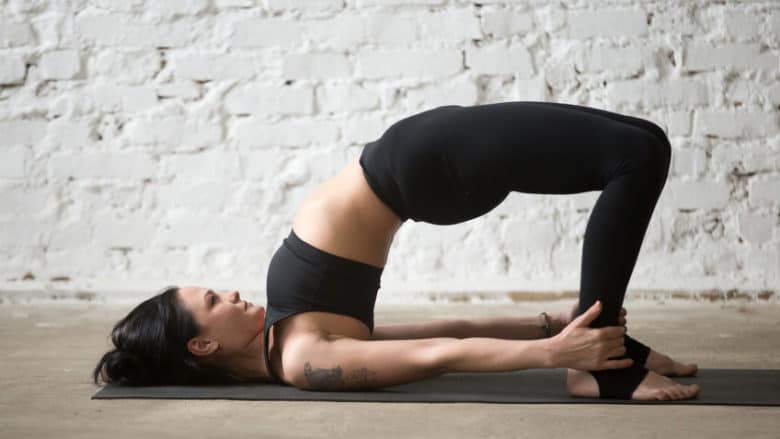
The Bridge Pose places your feet in support of your legs in firm contact with the ground while making dynamic contact with the spine. Also called Setu Bandhasana, this posture supports the health of your chakras, strengthens your back, helps make the spine more flexible, and opens the chest and shoulders.
Bridge Pose Precautions
Do not try this pose unless you are under the supervision of a yoga therapist or experienced yoga teacher if you have had neck or back problems such as malformations of the back, scoliosis, sacroiliac joint derangement, facet syndrome, spinal stenosis, a fracture, or severe osteoporosis.
Bridge Pose Tips
- Remember that yoga poses require focused attention and do not involve force.
- Always be gentle with yourself. Listen to your body and gradually extend the time you hold the pose.
- Avoid squeezing your buttocks too tightly.
- Relax your neck, throat and jaw as your breath.
- Be sure to keep your legs and feet parallel.
- Use a folded blanket under your shoulders and upper arms if your neck feels sore or tight.
Steps
- Begin lying on your back with your arms straight at your side with palms down. Bend your knees, placing your feet parallel to each other, hip-width apart, so that your heels come just to the tips of your fingers.
- Take a few breaths to inflate your body, and soften any tension.
- Press your feet even more firmly into the floor as you slowly lift your spine, vertebrae by vertebrae, similar to lifting a strand of pearls, one pearl at a time, until you are resting on your feet and upper back vertebrae.
- If not too uncomfortable, clasp your hands together under your back, pressing the chest upward and the shoulders together beneath you. Ideally the line between your knees and shoulders should form a straight plane.
- Feel the support of your legs and feet. Feel the spine connected and energized by the support. Feel your chest open.
- Breathe deeply and hold for at least three complete breaths.
- Return your spine to the floor, again one vertebrae at a time, at last relaxing the buttocks and allowing the feet and legs to relax. You can keep the knees bent if you wish to repeat the pose, or allow them to lie flat on the floor.
- Take a few moments to feel the energy and relaxation coming into your chakras, coming into your body.
Benefits
This pose stretches the chest, neck and spine; and stimulates abdominal organs, lungs and thyroid. Among its many yoga benefits it helps the following:
- Stress
- Mild depression
- Fatigue and tired legs
- Digestion
- Symptoms of menopause
- Menstrual discomfort (with supports)
- Anxiety
- Backache and Headache
- Insomnia
- High blood pressure
- Osteoporosis
- Sinusitis
Bridge Pose Key Points
Bridge pose supports the health of your chakras and improves the strength and flexibility of your spine. It vitalizes your whole body and has many benefits.
Please consult your physician before starting this or any exercise program.
Sources and Resources
Fishman, L. and Saltonstall, E. Yoga for Arthritis (New York: Norton, 2008).
Judith, Anodea, Wheels of Life: A User’s Guide to the Chakra System, (Woodbury, MN: Llewellyn Publications, 2012).
